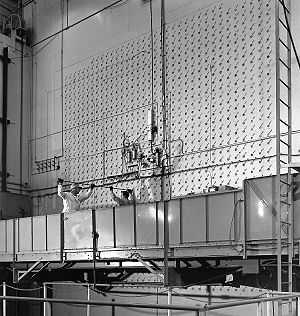X-10 Graphite Reactor
|
X-10 Reactor, Oak Ridge National Laboratory | |
 | |
|
Workers in the Graphite Reactor used rods to push fresh uranium slugs into the reactor's concrete loading face. | |
 | |
| Location | Oak Ridge National Laboratory |
|---|---|
| Nearest city | Oak Ridge, Tennessee |
| Coordinates | 35°55′34.8486″N 84°18′59.2662″W / 35.926346833°N 84.316462833°WCoordinates: 35°55′34.8486″N 84°18′59.2662″W / 35.926346833°N 84.316462833°W |
| Area | less than 1-acre (4,000 m2)[1] |
| Built | 1943 (Reactor shut down 1963) |
| Governing body | U.S. Dept of Energy |
| NRHP Reference # | 66000720 |
| Significant dates | |
| Added to NRHP | October 15, 1966[2] |
| Designated NHL | December 21, 1965[3] |
The X-10 Graphite Reactor at Oak Ridge National Laboratory in Oak Ridge, Tennessee, formerly known as the Clinton Pile and X-10 Pile, was the world's second artificial nuclear reactor (after Enrico Fermi's Chicago Pile) and was the first reactor designed and built for continuous operation.[4]
Design
When President Roosevelt in December 1942 authorized the Manhattan Project, the Oak Ridge site in eastern Tennessee had already been obtained for the Clinton Engineer Works and plans had been laid for establishing an air-cooled experimental pile, a pilot chemical separation plant, and support facilities. The X-10 Graphite Reactor, designed and built in ten months, went into operation on November 4, 1943. The reactor used neutrons emitted in the fission of uranium-235 to convert uranium-238 into a new element, plutonium-239.
The reactor consists of a huge block of graphite, measuring 24 feet (7.3 m) on each side, surrounded by several feet of high-density concrete as a radiation shield. The block is pierced by 1,248 horizontal diamond-shaped channels in which rows of cylindrical uranium slugs formed long rods. Cooling air circulated through the channels on all sides of the slugs. After a period of operation, operators pushed fresh slugs into the channels from the face of the pile and the irradiated slugs would fall from the back wall through a chute into an underwater bucket. Following weeks of underwater storage to allow for decay in radioactivity, the slugs were delivered to the chemical separation building.
The X-10 Graphite Reactor supplied the Los Alamos laboratory with the first significant amounts of plutonium. Fission studies of these samples from the reactor heavily influenced bomb design. The X-10 chemical separation plant also proved the bismuth phosphate process that was used in the full-scale separation facilities at Hanford. Finally, the reactor and chemical separation plant provided invaluable experience for engineers, technicians, reactor operators, and safety officials who then moved on to the Hanford site.
Peacetime use
After the war ended, the graphite reactor became the first facility in the world to produce radioactive isotopes for peacetime use. On August 2, 1946, ORNL director Eugene Wigner presented a small container of carbon-14 to the director of the Barnard Free Skin and Cancer Hospital, for medical use at the hospital in St. Louis.[5] Subsequent shipments of radioisotopes, primarily iodine-131, phosphorus-32, and carbon-14, were intended for scientific, medical, industrial and agricultural uses.

The Graphite Reactor at X-10 was shut down in 1963, after twenty years of use.[6] It was designated a National Historic Landmark in 1966.[1][3] In 1969 the American Society for Metals listed it as a landmark for its contributions to the advancement of materials science and technology.[4] In 2008 it was designated as a National Historic Chemical Landmark by the American Chemical Society.[5] The control room and reactor face are accessible to the public during scheduled tours offered through the American Museum of Science and Energy.
Similar reactors
One reactor of similar design as the X-10 reactor is still in operation today, the Belgian BR-1 reactor in Mol, Belgium. It is used for scientific purposes, such as neutron activation analysis, neutron physics experiments and calibration of nuclear measurement devices.[7]
The X-10 reactor was similar in design to the Windscale reactors in Cumbria, England, which were constructed for the British Ministry of Supply and later operated by the Atomic Weapons Establishment. One of the two gas cooled reactors at Windscale caught fire in 1957.
References
- ↑ 1.0 1.1 Polly M. Rettig (December 8, 1975). National Register of Historic Places Inventory-Nomination: X-10 Reactor, Graphite Reactor (pdf). National Park Service. and Accompanying three photos, interior, undated PDF (32 KB)
- ↑ "National Register Information System". National Register of Historic Places. National Park Service. 2008-04-15.
- ↑ 3.0 3.1 "X-10 Reactor, Oak Ridge National Laboratory". National Historic Landmark summary listing. National Park Service. Retrieved 2008-10-07.
- ↑ 4.0 4.1 "ORNL Metals and Ceramics Division History, 1946-1996". Oak Ridge National Laboratory. ORNL/M-6589. Retrieved January 25, 2015.
- ↑ 5.0 5.1 Peacetime use of radioisotopes at Oak Ridge cited as Chemical Landmark, American Chemical Society news release, Feb. 25, 2008
- ↑ X-10, The Tennessee Encyclopedia of History and Culture. Tennessee Historical Society. Accessed November 3, 2009.
- ↑ BR1 - Belgian Reactor 1, Belgian Nuclear Research Centre website, accessed October 8, 2008
External links
| Wikimedia Commons has media related to X-10 Graphite Reactor. |
- The Manhattan Project: Making the Atomic Bomb
- Site X A map of Manhattan Project era Oak Ridge, Tennessee.
- ORNL webpage about the Graphite Reactor
- National Historic Landmark nomination file on the X-10 Graphite Reactor
| ||||||||||||||||||||||||||||||||||||||
| ||||||||||||||||||||||||||
